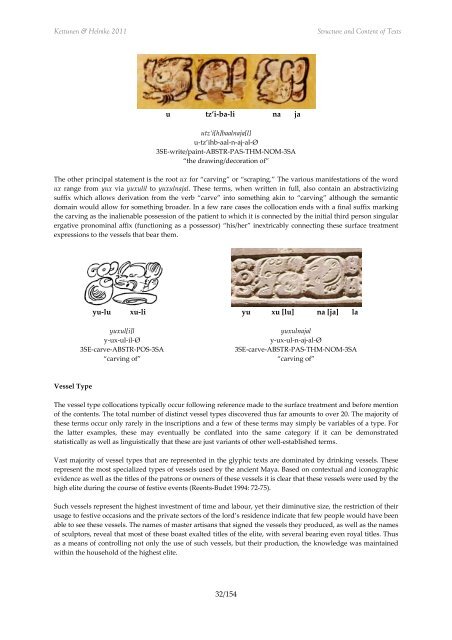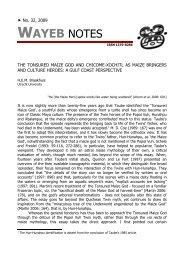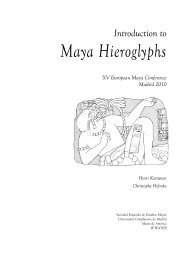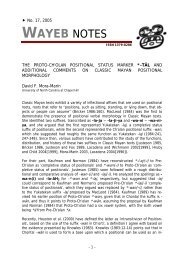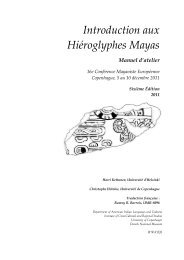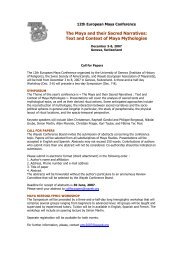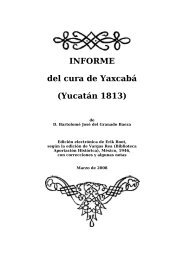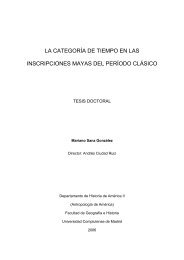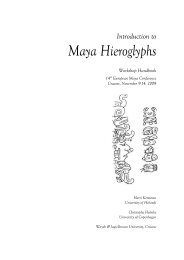Introduction to Maya Hieroglyphs - Wayeb
Introduction to Maya Hieroglyphs - Wayeb
Introduction to Maya Hieroglyphs - Wayeb
You also want an ePaper? Increase the reach of your titles
YUMPU automatically turns print PDFs into web optimized ePapers that Google loves.
Kettunen & Helmke 2011<br />
Structure and Content of Texts<br />
u tz’i-ba-li na ja<br />
utz’i[h]baalnaja[l]<br />
u-tz’ihb-aal-n-aj-al-Ø<br />
3SE-write/paint-ABSTR-PAS-THM-NOM-3SA<br />
“the drawing/decoration of”<br />
The other principal statement is the root ux for “carving” or “scraping.” The various manifestations of the word<br />
ux range from yux via yuxulil <strong>to</strong> yuxulnajal. These terms, when written in full, also contain an abstractivizing<br />
suffix which allows derivation from the verb “carve” in<strong>to</strong> something akin <strong>to</strong> “carving” although the semantic<br />
domain would allow for something broader. In a few rare cases the collocation ends with a final suffix marking<br />
the carving as the inalienable possession of the patient <strong>to</strong> which it is connected by the initial third person singular<br />
ergative pronominal affix (functioning as a possessor) “his/her” inextricably connecting these surface treatment<br />
expressions <strong>to</strong> the vessels that bear them.<br />
yu-lu xu-li yu xu [lu] na [ja] la<br />
yuxul[i]l<br />
y-ux-ul-il-Ø<br />
3SE-carve-ABSTR-POS-3SA<br />
“carving of”<br />
yuxulnajal<br />
y-ux-ul-n-aj-al-Ø<br />
3SE-carve-ABSTR-PAS-THM-NOM-3SA<br />
“carving of”<br />
Vessel Type<br />
The vessel type collocations typically occur following reference made <strong>to</strong> the surface treatment and before mention<br />
of the contents. The <strong>to</strong>tal number of distinct vessel types discovered thus far amounts <strong>to</strong> over 20. The majority of<br />
these terms occur only rarely in the inscriptions and a few of these terms may simply be variables of a type. For<br />
the latter examples, these may eventually be conflated in<strong>to</strong> the same category if it can be demonstrated<br />
statistically as well as linguistically that these are just variants of other well-established terms.<br />
Vast majority of vessel types that are represented in the glyphic texts are dominated by drinking vessels. These<br />
represent the most specialized types of vessels used by the ancient <strong>Maya</strong>. Based on contextual and iconographic<br />
evidence as well as the titles of the patrons or owners of these vessels it is clear that these vessels were used by the<br />
high elite during the course of festive events (Reents-Budet 1994: 72-75).<br />
Such vessels represent the highest investment of time and labour, yet their diminutive size, the restriction of their<br />
usage <strong>to</strong> festive occasions and the private sec<strong>to</strong>rs of the lord’s residence indicate that few people would have been<br />
able <strong>to</strong> see these vessels. The names of master artisans that signed the vessels they produced, as well as the names<br />
of sculp<strong>to</strong>rs, reveal that most of these boast exalted titles of the elite, with several bearing even royal titles. Thus<br />
as a means of controlling not only the use of such vessels, but their production, the knowledge was maintained<br />
within the household of the highest elite.<br />
32/154


